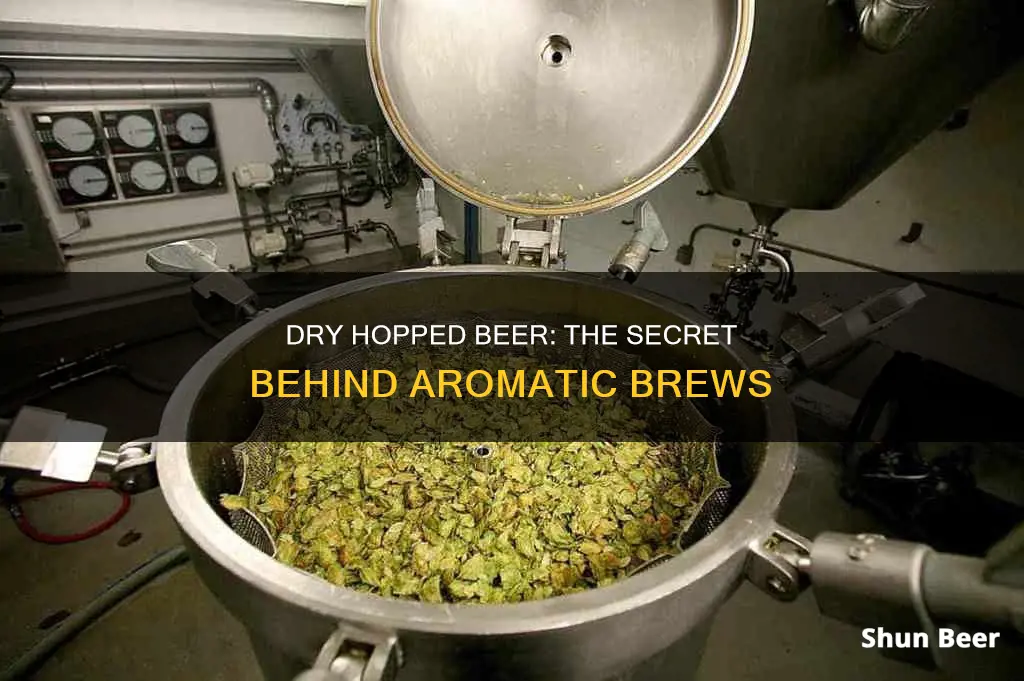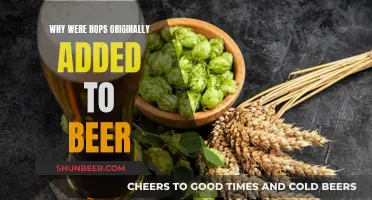
Dry hopping is a brewing technique that involves adding hops to beer during the fermentation, conditioning, or serving stage of the brewing process. It is done to amplify the aroma and flavour of the beer without increasing its bitterness. The technique is often used for beers like pale ales and IPAs to give them a floral hop essence and an intense flavour. The origins of dry hopping can be traced back to British brewers who added hops to casks to preserve the beer during long journeys.
| Characteristics | Values |
|---|---|
| Definition | A brewing term for adding hops late in the brewing process, either during fermentation or conditioning |
| Origin | British brewers, centuries ago |
| Purpose | To amplify aromas and flavours without adding bitterness |
| Timing | During fermentation, conditioning, or serving |
| Flavour | "Hoppy", floral, fruity, piney, juicy, grassy, oily |
| Aroma | Hoppy, floral, fruity, piney, juicy, grassy |
| Bitterness | Does not add bitterness, as hops are not boiled |
| Sanitation | Hops do not need to be sanitised, as they do not provide a supportive environment for most types of bacteria |
| Amount | "As much as you want", typically 1-2 oz. for a 5-gallon batch |
| Form | Pellets, plugs, or loose |
What You'll Learn
- Dry hopping is a technique used to add flavour and aroma to beer
- It involves adding hops during fermentation or conditioning
- Hops are added to the beer without boiling them first
- Dry hopping is associated with English pale ales and American craft beers
- The technique dates back centuries and originated in Britain

Dry hopping is a technique used to add flavour and aroma to beer
Hops are added to beer at different stages of the brewing process to achieve different results. Hops added at the beginning of the wort boil contribute bitterness, while those added at the midpoint add bitterness and some aromatics. "Late hopping", or adding hops at the end of the boil, is intended for hop aroma and flavour. However, the reality is that late hopping often adds a significant proportion of a beer's bitterness as well.
Dry hopping is a cold infusion technique that intensifies hop aromatics in beer and adds aromatics that are substantially different from those achieved by late hopping. It does not add bitterness to the beer, as boiling is necessary to convert the alpha acids in the hops to iso-alpha acids to create bitterness.
The technique originated in Britain centuries ago, where brewers would add hops to the cask shortly before shipping it off to the customer. It was used to help preserve the beer during long journeys across the ocean, as hops have antibacterial qualities. In the mid-1800s, the most common technique was to add a large handful of dried whole hops to the cask before filling.
Today, dry hopping is commonly used to maximise the flavour and hop character of beer. It can be done in the primary or secondary fermenter, or by adding hops directly to a keg. The secondary fermenter is generally considered the best place for dry hopping as the vigorous CO2 activity of the primary is finished, so the aroma of the hops won’t be scrubbed out of the beer.
Different varieties of hops can be used for dry hopping, such as Cascade, Crystal, Willamette, East Kent Golding, Fuggle, Saaz, Hallertau, and Tettnanger. The amount of hops used can vary depending on the desired intensity of flavour and aroma, but a "normal" measurement for dry hopping is between 1–2 oz. (28–56 g) of hops for a five-gallon (19-L) batch.
Dry hopping is a popular technique in modern craft brewing, especially for IPAs and other hop-forward beers. It allows brewers to create beers with a bright, hoppy character and intense flavour profiles.
The Evolution of Tropical Hops in Beer
You may want to see also

It involves adding hops during fermentation or conditioning
Dry hopping is a brewing term for adding hops late in the brewing process, specifically during fermentation or conditioning. This technique amplifies the aroma and flavour of the beer without increasing its bitterness.
Hops contain lupulin, the tiny glands that hold the resins and essential oils responsible for the flavour, aroma, and bitterness of IPAs and other hop-forward beers. Resins are not water-soluble, so by adding hops during the fermentation stage, alcohol is produced, and resins are alcohol-soluble, thus intensifying the flavour and bitterness of the beer.
The timing of dry hopping is important. Brewers tend to add hops during the "cold side" of brewing, when ales and lagers are transferred from kettles to fermentation tanks. This is because the essential oils in hops are sensitive and respond differently to heat. A long boil can cause these oils to be lost, and they are responsible for the big hop aromas of an IPA.
Dry hopping can be done in a few different ways and at different times during the brewing process. Some brewers dry hop twice, once after the beer has fermented for 48 hours, and again at the very end of fermentation. This method brings different flavours to the beer. At the 48-hour mark, a juicy, fruity flavour is achieved, while dry hopping at the end of fermentation results in a piney flavour.
The dry hopping method is not a one-size-fits-all process, and there are several ways to approach it. Some craft brewers recirculate hops so they are mixed into the whole tank, while others prefer to throw the hops into the top of the tank for exceptional flavour.
The amount of hops added during dry hopping can vary. A "normal" measurement is between 1-2 oz (28-56 g) of hops for a five-gallon (19-L) batch. However, some brewers use as much as 4 oz (112 g) of hops for a stronger hop flavour and aroma.
Dry hopping is a technique that has been used for centuries, originally by British brewers to preserve beer during long journeys across the ocean before refrigeration was available. Today, it is widely used to maximise the flavour and hop character of beer, especially in the American craft brewing movement.
The Best Grain-Free, Hop-Free Beers You Can Enjoy
You may want to see also

Hops are added to the beer without boiling them first
Dry hopping is a brewing term for adding hops late in the brewing process, either during fermentation or conditioning. The purpose of dry hopping is to infuse beer with additional fresh hop flavour and aroma.
Dry hopping is a cold infusion technique that intensifies hop aromatics in beer and adds aromatics that are substantially different from those achieved by late hopping. The alpha acids responsible for bitterness are not isomerized and therefore remain insoluble during dry hopping. However, tasting trials have shown that the bitterness perception of beer can be increased by dry hopping, although international bitterness unit values may remain unchanged.
The hops are usually added to the beer after fermentation, when the beer has been cooled and the yeast has sedimented out. Dry hopping during active fermentation is less common, although some brewers do it because they feel that the continuing yeast activity can remove the oxygen introduced by dry hopping.
The benefit of dry hopping is that the brewer can get as much flavour and aroma as possible into the final beer, giving it a floral hop essence and an intense flavour that is desirable in hoppy beer styles like pale ales and IPAs.
Icehouse Beer: Hops or No Hops?
You may want to see also

Dry hopping is associated with English pale ales and American craft beers
Dry hopping is a brewing technique that involves adding hops to beer late in the brewing process, either during fermentation or conditioning. The process was first created by UK brewers in the 1800s, who added hops to casks to freshen and preserve the beer during transportation. Today, dry hopping is commonly used in a range of ales, including American Pale Ales and IPAs, as well as sour beers, dark/amber American ales, Belgian ales, and lagers.
English-style Pale Ales can be dry-hopped, and some home brewers do so, but it is not traditional. Dry hopping an English Pale Ale can change the style of the beer, making it more similar to an APA.
The timing of dry hopping is important to achieve the desired flavour. If hops are added too early, the increased carbon dioxide production and vigorous nature of primary fermentation can "scrub off" the hop characters. Therefore, it is generally best to dry hop towards the end of the primary fermentation period. The duration of dry hopping can vary depending on the desired flavour profile, but it typically ranges from 24 hours to 10 days.
Different techniques can be used for dry hopping, such as loose dry hopping or using a hop bag/ball. Loose dry hopping involves throwing hops directly into the fermenter, allowing for increased extraction of hop oils. However, this technique has limited control over the contact time of the hops and may result in hop material transferring to the packaged bottles or kegs. Using a hop bag/ball contains the hops and makes them easier to remove, but if packed too tightly, it can reduce the extraction of hop oils.
The amount of dry hops used can vary depending on the style of beer and the desired intensity of the hop character. A general rule of thumb is to use higher dosage rates for higher alcohol content beers.
Hop Butcher's Lactose: A Universal Addition?
You may want to see also

The technique dates back centuries and originated in Britain
Dry hopping is a technique in the beer-brewing process where hops are added to the beer during the fermentation or conditioning stage. The purpose of dry hopping is to infuse the beer with fresh hop flavour and aroma. The technique is most closely associated with English pale ales and their variants.
The technique dates back to 12th-century Germany, when a nun named Hildegard discovered that hops keep putrefaction at bay. Hildegard would add hops at the end of the brewing process as a preservative, resulting in a minor bitter flavour and scent. By the 1800s, the use of hops surpassed gruit in popularity, and brewers continued the practice of dry hopping to create aroma, instead of the strong bitter flavour that results from boiling hops in the wort.
Dry hopping has old roots but became popular again in the 1980s with a new wave of craft brewers in the US. Today, almost all kinds of beer are dry hopped, from light Pilsners and hoppy IPAs to rich stouts.
Where to Find Tropical Hop Beer Near You
You may want to see also
Frequently asked questions
Dry hopping is a brewing term for adding hops late in the brewing process, either during fermentation or conditioning.
Dry hopping adds flavour and aroma to the beer. It does not add bitterness, as boiling is necessary to convert the alpha acids in the hops to iso-alpha acids to create bitterness.
Some commercial beers that are dry-hopped include Sierra Nevada's Celebration Ale, Young's Special Ale, Anchor Liberty, and Sam Adams Pale Ale.







